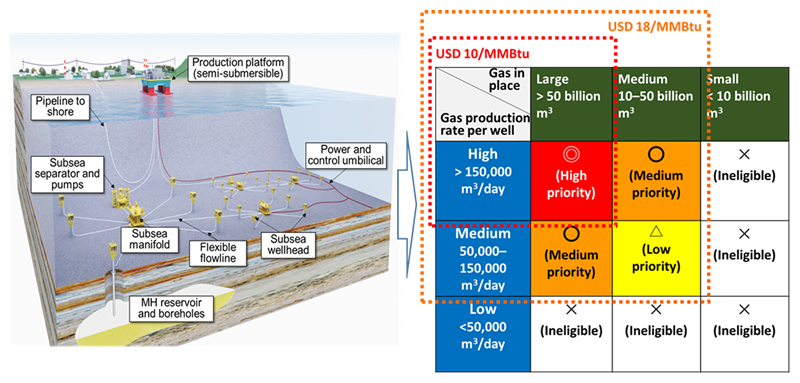About MH21-S
Project Targets in 2025
The MH21 research program that started in 2001 was concluded in early 2019, yielding many outcomes. These outcomes included the discovery of highly concentrated methane hydrate deposits (methane hydrate concentrated zones) in sandy layers of turbidite sediments, verification of the “depressurization technique” as an energy-efficient gas production measure through laboratory and empirical experiments, and onshore and offshore production tests that large amounts of valuable data were derived from. However, there is still a long way to go to achieve the project’s goal of introducing marine methane hydrates into Japan’s domestic resource portfolio.
To realize the long-term goal of the project, namely commercialization of Japan’s offshore methane hydrate resources, a new offshore production test in Japanese waters is being planned for after the Phase Four. As criteria for advancing to the next research and development phase, the consortium has created quantitative targets based on economical analysis. This is essential to demonstrating that methane hydrate offshore Japan can be a viable energy resource.
The conditions for the new test were defined through an economic analysis of the assumed offshore production systems, under realistic future gas prices and deepwater technology scenarios (see article) . Results of this analysis revealed that two dominant factors determine the economic viability of the resource: (1) the scale of the resource, measured as gas volume in place; and (2) the average gas production rate for a given well. Economic criteria associated with these factors were evaluated on a quantitative basis.
An appropriate candidate test site must have sufficient resource volume to supply future gas production fields, and it must undergo a preliminary environmental impact analysis. To qualify as an appropriate site, the minimum gas volume in place at the site must be 10 billion m3 (0.35 Tcf). Another major condition is that the expected average gas production rate, must be above 50,000 m3/day (1.8 mmscf/day) (Fig 1). Project targets in the Phase Four include achieving the above goals.

Fig.1 An assumed gas production system, the evaluated economic criteria of gas volume in place, and gas production rate per well

